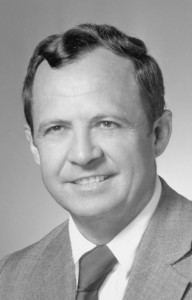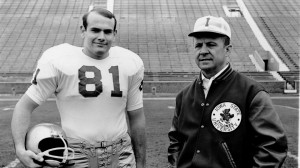 AMES, Iowa – Clay Stapleton, the man who led Iowa State football to one of its most memorable seasons with the 1959 “Dirty Thirty” team, passed away this morning in Missouri City, Mo. He was 93 years old.
AMES, Iowa – Clay Stapleton, the man who led Iowa State football to one of its most memorable seasons with the 1959 “Dirty Thirty” team, passed away this morning in Missouri City, Mo. He was 93 years old.
Stapleton dedicated his life to athletics, and from 1958-70, Iowa State University bore the fruits of his labor while he was head football coach and athletic director. When ISU athletics director Louis Menze was searching to replace departed grid coach Jim Myers, he wanted a candidate that would stay with the balanced line single-wing offense. Menze turned to Stapleton, a college roommate of former coach Jim Myers.
Stapleton had already built a strong football resume before taking over the reins of the Cyclone football program in 1958. A native of Fleming, Ky., Stapleton starred at the Tennessee before embarking on his coaching career. He started his career at Wofford (S.C.) College and then assisted at Wyoming from 1953-54 before moving on to Oregon State. In his three seasons in Corvallis (1955-57), the Beavers earned two trips to the Rose Bowl.
The Iowa State football program had not had a winning season since 1949 when Stapleton arrived in Ames. He quickly installed his single-wing attack, an offense that relied on quickness, deception and two-on-one blocking that compensated for his diminutive teams. The Cyclones finished 4-6 in his first season, as the Cyclone defense led the nation in pass defense, yielding just 390 yards and 88 points. He started to showcase the power of the single-wing in his next two seasons, collecting back-to-back seven-win seasons in 1959 and 1960.
“Everything that I was taught as a coach, I learned from playing under Coach Stapleton,” said College Football Hall of Fame coach John Cooper, who played for Stapleton at Iowa State from 1959-61. “After my senior season I went to Coach Stapleton to ask if he could help me get into coaching and he told me, ‘John, I think you would make a hell of a coach. I want you to stay here at Iowa State and coach my freshmen team next year.’ I owe everything to him in helping me get started in the coaching profession.”
Heading into the 1959 season, injuries and departures had depleted the Cyclone roster to just a mere 30 players. Despite its low numbers, the tough little gang won its season opener in grand fashion over Drake (41-0) on a muddy field in Des Moines. When the team was heading back into the locker room, ISU trainer Warren Ariail yelled out, “here comes the ‘Dirty Thirty.’” The moniker stuck and the team captured the hearts and imaginations of the collegiate football world. The “Dirty Thirty” finished the season at 7-3, falling at powerhouse Oklahoma in the final game of the season to miss out on a chance to compete in the Orange Bowl. Stapleton’s “Dirty Thirty” squad featured running back Tom Watkins and quarterback Dwight Nichols, who finished second and third nationally in rushing, respectively. Nichols earned All-America honors and was named Big Eight Player of the Year for the second season in a row. Nichols was the first Cyclone to be a finalist in the Heisman Trophy balloting, finishing eighth in 1959.
Des Moines. When the team was heading back into the locker room, ISU trainer Warren Ariail yelled out, “here comes the ‘Dirty Thirty.’” The moniker stuck and the team captured the hearts and imaginations of the collegiate football world. The “Dirty Thirty” finished the season at 7-3, falling at powerhouse Oklahoma in the final game of the season to miss out on a chance to compete in the Orange Bowl. Stapleton’s “Dirty Thirty” squad featured running back Tom Watkins and quarterback Dwight Nichols, who finished second and third nationally in rushing, respectively. Nichols earned All-America honors and was named Big Eight Player of the Year for the second season in a row. Nichols was the first Cyclone to be a finalist in the Heisman Trophy balloting, finishing eighth in 1959.
Stapleton had to replace Nichols prior to the 1960 season. In his place was Dave Hoppman. Hoppman quarterbacked the Cyclones to another 7-3 finish. Hoppman and Watkins finished fifth and 12th, respectively, in the final NCAA rushing statistics. The highlight of the 1960 season was a 10-6 victory over Oklahoma at Clyde Williams Field. It was the first victory over the Sooners since 1931, played in front of the first sold-out home crowd in decades. Watkins earned All-America honors in 1960 and Hoppmann was ISU’s first two-time All-American in 1961 and 1962.
Stapleton had a six-year run coaching a Cyclone back who ranked among the top-12 players nationally in rushing from 1958-63. That stretched included four consecutive years (1958-61) of producing the Big Eight Conference rushing leader. In that span, Stapleton tutored four All-American backs (Nichols, Watkins, Hoppman and Tom Vaughn). His diverse offense also produced outstanding receivers. Eppie Barney played three seasons for Stapleton, earning All-America honors in 1966 while breaking every Cyclone pass-catching mark.
Stapleton compiled a 42-53-4 mark in 10 seasons, the second-longest tenure and the second-most wins in school history. He put away the whistle and retired from coaching in 1967. He coached six All-Americans and sent 13 players into eight major bowl or all-star games.
Stapleton would serve as athletics director at Iowa State from 1967-70, where he was instrumental in the beginning phases of building a new football stadium (Jack Trice Stadium) and basketball arena (Hilton Coliseum). He also played a significant role in the resumption of the annual Iowa State-Iowa football series.
Among his successes as athletics director was the hiring of head football coach Johnny Majors. Stapleton handpicked the 33-year-old Majors to be his successor. Majors led the Cyclones to bowl games in 1971 and 1972.
Stapleton left Iowa State in 1970 and was the athletics director at Florida State and Vanderbilt before retiring.
Stapleton was inducted into the ISU Letterwinners Club Athletics Hall of Fame in 2006.








